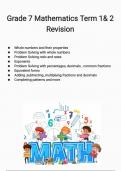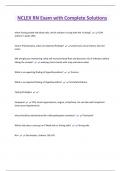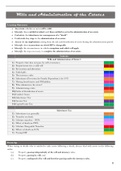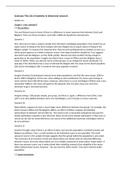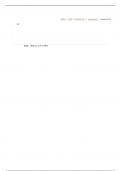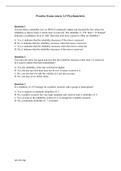Table of Content
Chapter 1 - ............................................................................................................................................................... 2
Chapter 2 – From trial and error to the science of management. The rise of organisation theory ................ 2
Chapter 3 – Developments in organisational theory. From certainty to contingency...................................... 3
Chapter 4 – The Cultural Excellence Paradigm .................................................................................................. 9
Chapter 5 – Alternative paradigms: Japanese management, organisational learning and the need for
sustainability ......................................................................................................................................................... 14
Chapter 6 – Critical perspectives on organisation theory. Postmodernism, realism and complexity .......... 18
Chapter 7 – Culture, power, politics and choice ................................................................................................ 22
Chapter 8 – Approaches to Strategy. Managerial choice and constraints ...................................................... 27
Chapter 9 – Planned Change and Organization Development (OD) ............................................................... 32
Chapter 10 – Developments in Change Management. Emergence challenges Emergent change as OD
strikes back............................................................................................................................................................ 36
Chapter 11 – a framework for change ................................................................................................................ 40
Chapter 12 - Organizational Change and Managerial Choice ......................................................................... 42
Chapter 13 – Organizational change and managerial Choice .......................................................................... 45
Chapter 14 – Management, leadership and change .......................................................................................... 48
1
,Chapter 1 – Fundamental questions for organizations
Two schools:
1. Individual perspective school
Behaviorist psychology (behavior) and gestalt-field theory.
2. The group dynamics school
From individual to group level.
3. The open systems school
Open systems. Environment wordt belangrijker.
Resistance:
Theory 1 – Cognitive dissonance. People experience two types of values/feelings and choose
to bend or resist.
Theory 2 – Depth of intervention. The greater the effect on the individual, the deeper the level
of involvement required to be successful.
Theory 3 – Psychological contract. Unwritten set of expectation operating at all times
between every member of an organization and the various managers and others in that
organization.
Theory 4 – Dispositional resistance. People with a character of high dispositional resistance
tend to resist change
Main models of organizational change
Incremental – incremental, step-wise
Punctuated equilibrium – long periods of equilibrium, then bursts of fundamental change
Continuous change – change in continuous manner
Chapter 2 – From trial and error to the science of management. The
rise of organisation theory
The classical approach
Basic assumptions:
- One best way for all operations
- Based on the rule of law and legitimate authority. Designed to ensure employees’
behaviour is geared solely to the efficient pursuit of the organisational goals.
- Organisations are rational entities
- People are motivated to work only by financial reward
- Human emotions should be eliminated
- Most appropriate form of job design: hierarchical, horizontal division of labour,
standardised procedures and rules, close monitoring/supervision.
Adam Smith
Divide aspects of work among workers, specializing on one aspect of the production. This is
more efficient because:
- Worker acquire greater dexterity
- Avoids time loss of a person moving from one task to another
2
, - Concentration on one task leads to invention of machines that aid the productivity of
labour and allow one person to do more work.
Frederick Taylor – Scientific Management
Basic beliefs:
- It is possible and desirable to establish the one best way of carrying out a job. Once
established, the way must be implemented totally.
- Humans seek maximum reward for minimum effort – soldiering. To overcome this,
managers need to give detailed instructions, supervise closely and link pay to
performance.
Scientific management, three core elements:
1. Systematic collection of knowledge about the work process by managers
2. Removal or reduction of workers’ discretion and control over what they do
3. Creating standard procedures and times for carrying out a job.
The Gilbreths – Motion study
Developed a number of procedures for breaking work down into components. Using flow-
charts. Split human motion into five elements: operations, transportation, inspection, storage
and delay. They broke handwork down in 17 basic elements: necessary and unnecessary.
Henry Fayol – Principles of organisation
Developed a universal approach to management for any organisation. Established 14
‘universal’ principles of organisation. In order to achieve this, five management duties:
Forecasting and planning →
Organising (resource allocation, developing structure)→
Commanding (ensure employees perform their jobs in the best way) →
Coordinating (verify activities to work harmoniously to achieve goals) →
Controlling (rules and commands are carried out)
Max Weber – Bureaucracy
Identified ‘three pure types of legitimate authority’
1. Rational-legal (based on normative rules, the right of those elevated to authority to
issue commands) for example: a boss receives the power of the organisation
2. Traditional (the immemorial traditions and the legitimacy of those exercising authority
under them) for example: a king just gains the power to have authority
3. Charismatic (exceptional sanctity, heroism or exemplary character of an individual
person)
Bureaucracy is characterized by division of labour. Standardisation of rules and procedures.
Chapter 3 – Developments in organisational theory. From certainty to
contingency.
Human relations school
Two similarities with classical school: 1. organisations are closed, changeless entities (once
structured themselves with the correct precepts, regardless of external and internal
developments, no further change is necessary) & 2. one best way to run the organisation.
3
, Besides these two, the human relations school forms a distinct break with the classical school.
Basic assumptions:
- People are emotional rather than economic-rational beings.
- Organisations are cooperative, social systems rather than mechanical ones.
- Organisations are composed of informal structures, rules and norms as well as formal
practices and procedures.
Mary Parker Follett – from Scientific Management to Human Relations
Core ideas of her approach to managing organisations:
- Create a system where workers accept managers’ authority. Managers base their
actions on the needs of the situation. On this point in line with Taylor.
- She stressed the group above the individual. Pride and self-worth were important
motivators for workers.
- Unlike Taylor: Conflict can play a positive role in creating a common purpose and
encouraging participation.
- Pursuit of a ‘common purpose’. This leads to as ‘invisible leader’. The role of the
manager is not to tell people what to do, but to coordinate and integrate their activities
in pursuit of the common purpose.
- No ‘expert’ who does all the thinking is needed. Organisational learning through
individual and group-development and participation.
Elton Mayo – Hawthorne Experiments
Special attention for workers makes them perform better, by increasing their morale. Two
major propositions:
1. Informal groups within organisations are important. See the work as a collective,
cooperative activity. These groups develop own norms, values and attitudes that
enable them to exert social, peer group pressure on individuals within the group to
conform to group norms.
2. Humans have a deep need for recognition, security and belonging. Workers’
performance could be influenced by this need.
Chester Bernard – Cooperative systems
Put forward the idea of organisations as cooperative systems. He was the first to treat
organisations as systems rather than machines. Cooperation could not only be achieved by
financial rewards: he advocated a mixture of financial and non-financial inducements.
Financial rewards were weak-incentives that needed to be supported by other psychological
and sociological motivators. Systematic and purposeful communication should avoid negative
responses from workers. He saw communication through formal and informal structures as
being the key function of the executive.
Abraham Maslow – Hierarchy of Needs
Psychological needs – hunger, thirst, sleep etc.
Safety needs – security, protection against danger
Social needs – need to belong, gain love and affection. To be in
Company with others etc.
Esteem needs – desire to be respected, esteemed, for their
Achievements
4


